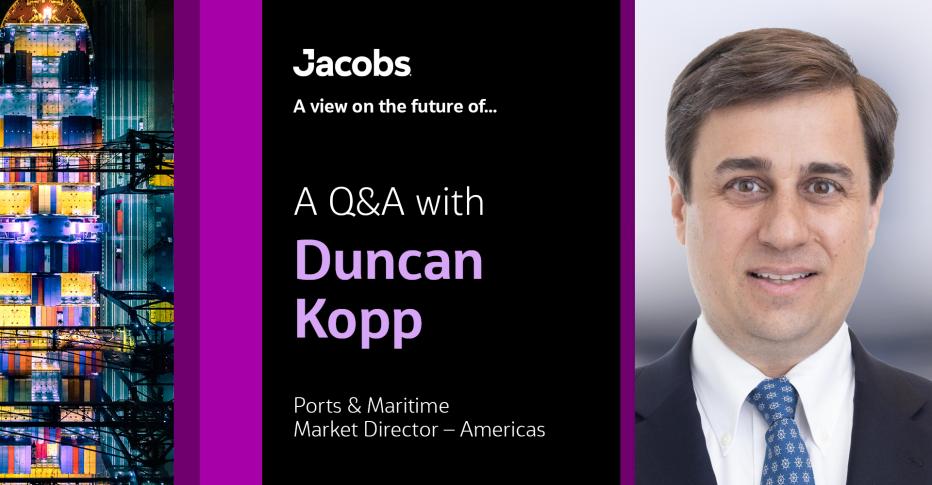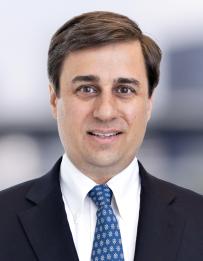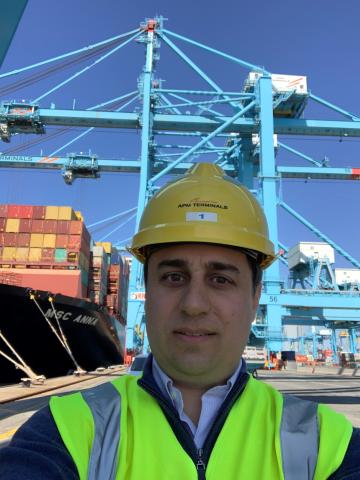
Ports & Maritime facilities are essential for global trade, economic development and supply chain efficiency and are linchpins connecting businesses and driving growth.
Jacobs’ port and maritime professionals have navigated the world’s largest and most complex programs, bringing in-depth understanding of the complex nature of maritime infrastructure, backed by global knowledge and local experience. We address top-of-mind issues, including decarbonization, electrification, resiliency, sea-level rise, infrastructure life extension, renewal and beyond – with the help of teammates like Duncan Kopp.
In this Q&A, we connect with Duncan, our new Americas market director for ports & maritime, to talk about the trends and opportunities that make an impact on ports & maritime solutions of tomorrow.
Tell us a bit about what a day in the life is like as Jacobs Americas Market Director for Ports & Maritime, and what we offer to our clients in this market.
At Jacobs, our Ports & Maritime team provides consulting, planning, engineering, architectural, construction management, and program management services to a wide variety of public and private clients. Our clients own and operate seaports that move cargo, cruise terminals and destinations, ferry terminals, urban waterfronts and parks, and military, defense and shipyard facilities.
With a broad set of capabilities, a diverse client base, and geographically distributed team, every day is different. I help connect our team members and clients around the country and world so that we can continue to bring innovative thinking and solutions to the dynamic industry. I’m also actively engaged on client projects, which could be helping a client expand a cargo terminal or decarbonize their operations.
What are the biggest challenges in ports & maritime today?
Each of our clients in the ports & maritime space face different challenges, based on location, mission, and type of entity, but the entire industry is collectively facing aging infrastructure, the need for increased funding (for maintenance and capital development), demand growth (including the movement of both cargo and people), decarbonization, climate change, digitization and geopolitical issues.
How do we help clients think differently to respond to these challenges and those of the future?
At Jacobs, we’ve provided solutions to these challenges before they even became mainstream challenges. For example, we have a team of engineer divers – who are licensed professional engineers and carry commercial diver certifications – that provide inspection, rehabilitation and asset management services to help our clients get more out of their waterfront structures and optimize maintenance and repair spend.
In Virginia, we’re currently serving as construction manager for the Port of Virginia’s new Offshore Wind Port at the Portsmouth Marine Terminal, which is repurposing an old, mothballed container terminal into a new state of the art offshore wind port, and we’re lead designer for the South Brooklyn Marine Terminal. This redevelopment project will serve as an operations and maintenance base and staging and assembly port for wind turbine installation. Projects like these examples are making use of existing infrastructure while providing new, purpose-built facilities that will support the budding offshore wind industry, and local jobs, for years to come.
During the COVID-19 pandemic, our team was integral in the planning and design of projects to increase the nation’s supply chain and port capacity and resiliency. We also helped find suitable locations for cruise ships to temporary berth while the industry was shuttered.
Looking forward, our partnership with other Jacobs’ end markets and offerings will enable our industry-leading Ports & Maritime team to continue to adopt to the changing industry needs and offer cutting edge services. I am particularly excited about bringing our digital offerings (including StreetLight), PA Consulting, and our decarbonization and green fleeting expertise to our clients.
Transportation has changed more in the last decade than the last six decades combined thanks to new innovations. Where do you see the industry heading from here?
I expect that we will see a greater focus on decarbonization including clients seeking alternatives to the status quo, such as new inland port development where cargo will move off-port by rail, thereby freeing up valuable port land and capacity to handle more cargo. I also expect to see an increase in the use of autonomous technologies, asset management and optimization, cruise facility development, increased recreational waterfront access, infrastructure privatization/P3s, and military and strategic defense infrastructure, both in North America and abroad.
What are the biggest opportunities ahead for transportation infrastructure in the Americas?
Ports are uniquely positioned to capture a myriad of opportunities.
For example, the shift toward zero emissions presents not only an opportunity to decarbonize terminals and facilities themselves, but also an opportunity for ports to capture new business of importing and exporting cargoes such as offshore wind components, hydrogen or alternative fuels, or even electrification infrastructure.
I also expect that the combination of asset management needs, funding gaps and artificial intelligence will lead to a host of opportunities on optimizing waterfront infrastructure – whether cargo or cruise terminals, or waterfront developments - demand for our waterfront is increasing and needs are competing, and the expense of building new infrastructure is significant.
Finally, there’s huge opportunity for partnerships and collaboration between industries, sectors, and clients, such as additional private investment in public-sector projects, the transfer of knowledge between industries (such as bringing bus fleet electrification best practices to marine terminals), or resiliency expertise and experience from the U.S. Northeast (such as the Jacobs-designed East Side Coastal Resilience project in New York City) to other resiliency and protection projects in other parts of the country or world.
Transportation fuels both economic and societal progress. Is there a project you’re particularly proud of?
I’m proud to be part of a multi-faceted, global team that delivers some incredible award winning and publicly visible projects, including those I’ve previously mentioned; Royal Caribbean’s Coco Cay private island; and the Port of San Francisco Waterfront Resilience Program. Equally exciting and important are our projects such as our engineer dive team’s contract with the U.S. Navy for architecture and engineering services on waterfront facilities outside of the continental U.S.
It's gratifying to see the tasks I have led over the last more than ten years for Port Newark Container Terminal, as part of their $1 billion expansion and modernization program, come to fruition as their facility expands to be able to efficiently accommodate more cargo.
About the interviewee

Recently named as Jacobs Market Director for Ports & Maritime in the Americas, Duncan Kopp has 17 years of experience in infrastructure development, focusing mainly on ports, terminals, and waterfront infrastructure around the world. Duncan works with clients to prepare and execute infrastructure development plans in support of their missions, business operations and priorities. He has led U.S. state and federal grant applications resulting in over $150 million of awards, and has delivered projects funded by hundreds of millions of dollars from grant programs. Duncan is a licensed professional engineer in Rhode Island, Massachusetts and Connecticut, and has a master’s degree from the Massachusetts Institute of Technology and a bachelor’s degree from Tufts University.
An avid sailor, Duncan spends much of his free time on the water. He also enjoys skiing, tennis, traveling, scuba diving, relaxing on the beach, and spending time with his family, including his 5-year-old daughter and newborn baby.













































